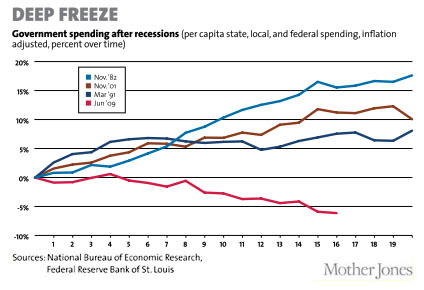
Here is Lori Montgomery in the Washington Post on the congressional budget negotiations currently in progress:
The deal expected to be sealed this week on Capitol Hill would not significantly reduce the debt, now $17.3 trillion and rising….Republicans and Democrats are abandoning their debt-reduction goals, laying down arms and, for the moment, trying to avoid another economy-damaging standoff.
The campaign to control the debt is ending “with a whimper, not a bang,” said Robert Bixby, executive director of the bipartisan Concord Coalition, which advocates debt reduction. “That this can be declared a victory is an indicator
of how low the process has sunk. They haven’t really done anything except avoid another crisis.”
There’s nothing wrong with talking about the federal deficit in a story about the budget. But this entire story is framed around a sense of dismay that Congress has “abandoned” its debt-reduction goals. This is done with no mention of the fact that Congress has already slashed the 10-year deficit by nearly $4 trillion over the past couple of years. No mention that we’ve been engaged in this frenzy of deficit cutting despite the fact that the economy is still fragile, which means that reducing the deficit is almost certainly a terrible idea. No mention that deficit cutting of any size in the wake of recession is unprecedented in recent history. No mention of the fact that the deficit has been falling for years and will continue to decline in 2014 and 2015.
Wait. That’s not true. There is a mention that the deficit will continue to fall over the next two years. It gets one sentence at the very tail end of the story:
Where would that leave the nation’s financial outlook? Not in a particularly good place, budget analysts say. The most recent Congressional Budget Office projections show the red ink receding over the next two years. But annual deficits would start growing again in 2016 as the baby-boom generation moves inexorably into retirement. And the debt would again soar.
This is crazy. A story that’s supposed to be evenhanded shouldn’t simply assume as its premise that any budget that fails to slash the deficit is a failure. That’s what Robert Samuelson and Jennifer Rubin are for. If it’s on the news pages, it should tell the whole story: plenty of people think that deficit cutting has already gone too far. But no reader of this piece would have any idea that this side of the story even existed.















